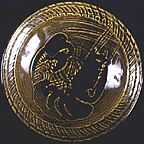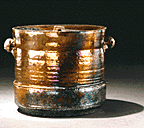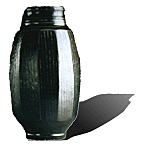
|

1983 RECIPIENT
Wayne Ngan — Potter
About the craftsperson
|

|
"In the pottery of Wayne Ngan we find, perhaps more strongly and
consistently than in the work of any other Canadian potter, the presence
in form and spirit of Far-Eastern ceramics. Today, Ngan has a firm
reputation as a totally committed studio potter. Living and working by the
sea, in a house and kiln-equipped studio all of his own design and making,
he has achieved an integration of his life and his art that embodies the
values of simplicity and wholeness at the centre of his personal
philosophy. Ngan's holistic approach to art is neither sought after nor
capable of realization by most craftspeople today, but his example has the
force and persuasiveness of the committed and productive visionary. Out of
this commitment have come works that reassert pottery's fundamental
meanings while at the same time they echo some of its great moments in
time."
Doris Shadbolt
Writer/Curator
North Burnaby, British Columbia
|

|
Ngan firing his reconstruction of a
Song-dynasty kiln, Hornby Island,
British Columbia, in 1988
|

|
|
The artistic talents of Wayne Ngan were evident to his Canadian teachers
shortly after he arrived in Vancouver from his native China at the age of
thirteen, and he was encouraged to go on to the Vancouver School of Art.
Although Ngan was especially interested in painting, he could not afford
the necessary materials and was obliged to enrol in the least expensive
studio course, pottery. Graduating with honours, Ngan set up his own
pottery and sculpture studio, began to teach, and gave pottery workshops.
Later, he settled on Hornby Island, off the west coast of British Columbia.
This move signalled a turning point in Ngan's development as a craftsman,
since it established his dedicated commitment to ceramics and initiated the
process of integrating his craft with his environment.
For four years, Ngan lived in a temporary shelter while building a kiln and
continuing to make pots. From the stone and driftwood he collected around
the island, he eventually created a house, a studio and a kiln shed. Within
this stimulating island environment, Ngan renewed his interest in his
Oriental heritage, and began experimenting with raku pottery, salt glazes
and Chinese brush techniques.
|
|
Later he travelled to China to study traditional pottery styles and
techniques and to Japan to work with a master potter. Preferring the
spontaneity and directness of ancient Oriental pottery, Ngan was
particularly impressed by the pure forms and etched decorative surfaces of
China's Song dynasty and Korea's El dynasty. On his return to Hornby
Island, he began to adapt these pottery styles and techniques to his own
ceramic vessels.
|

|
Shrimp bowl, 1978
Stoneware, iron glaze, wax resist image of shrimp
14 in. (diameter) x 3 ¼ in.
Image used with permission of the artist
Archives - Box 607, F1 and F2
|

|
|
Now Ngan often uses a kick wheel instead of the electric wheel, preferring
the physical communication between the clay and the potter's hands and
feet. He often fires green pottery in a wood-fired, instead of an
electrically heated, kiln to produce a soft-hued ceramic glaze. Working in
this way, Ngan not only participates directly, that is physically and
spiritually, in the firing of his pottery, but also carries on an ancient
Oriental tradition.
It is in these ways that he contributes to a wider appreciation of Asian
aesthetics in Canada, especially on the West Coast, where the Oriental
influence is prominent in architecture, landscaping and the visual arts.
|

|
Lidded Jar, 1985
Raku
20 cm (diameter) x 15 cm
CMC 86-111.1 to 2 (Bronfman)
|

|

|
Vase, 1981
Stoneware
Salt-glazed
17 cm (diameter) x 31 cm
CMC 86-109 (Bronfman)
|

|
|
Ngan's integration of craft and environment is a continuous process. He
intends to further explore local materials, using Hornby Island stone in
making glazes and British Columbia clay for his stoneware. He also has
aspirations to become better recognized as a painter and sculptor. For the
present, though, his contemplation of two interwoven heritages and the
integration of local materials into his craft, home and studio have brought
a certain elemental harmony into his life.
Reflecting on one of his pots, Ngan recognizes that:
"It's almost like a Song dynasty pot, but somehow it's not the same because
I digest those Song pots and ancient pottery and recreate my own liveliness.
You can't just copy something from the past — you have to live your
own life, living with your forms, and then they become part of you."
|

